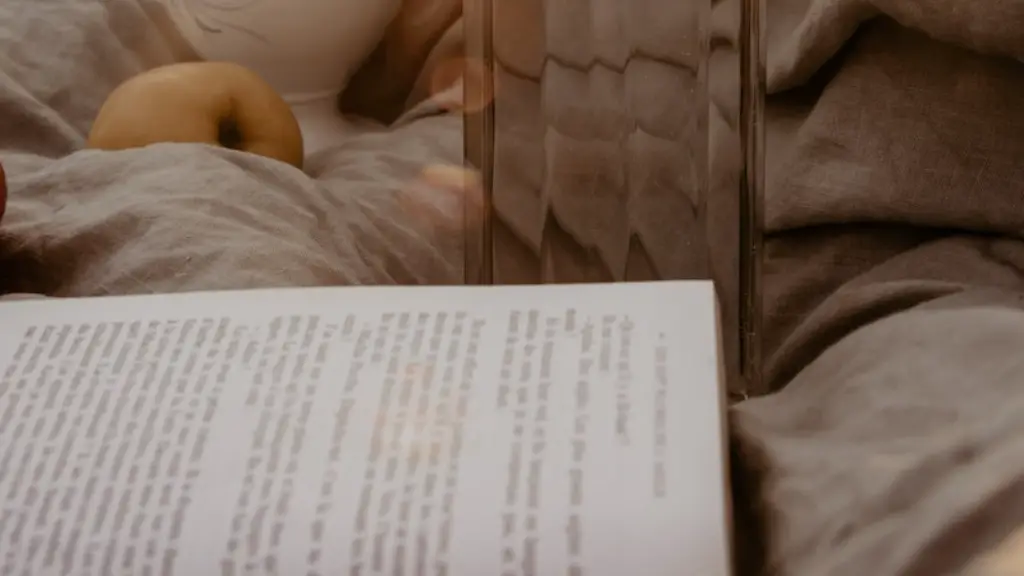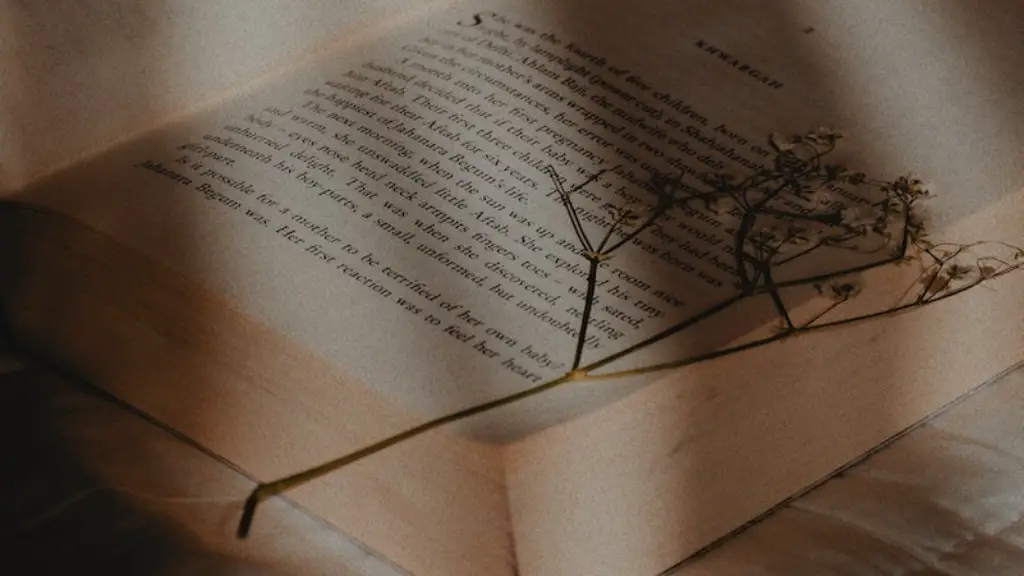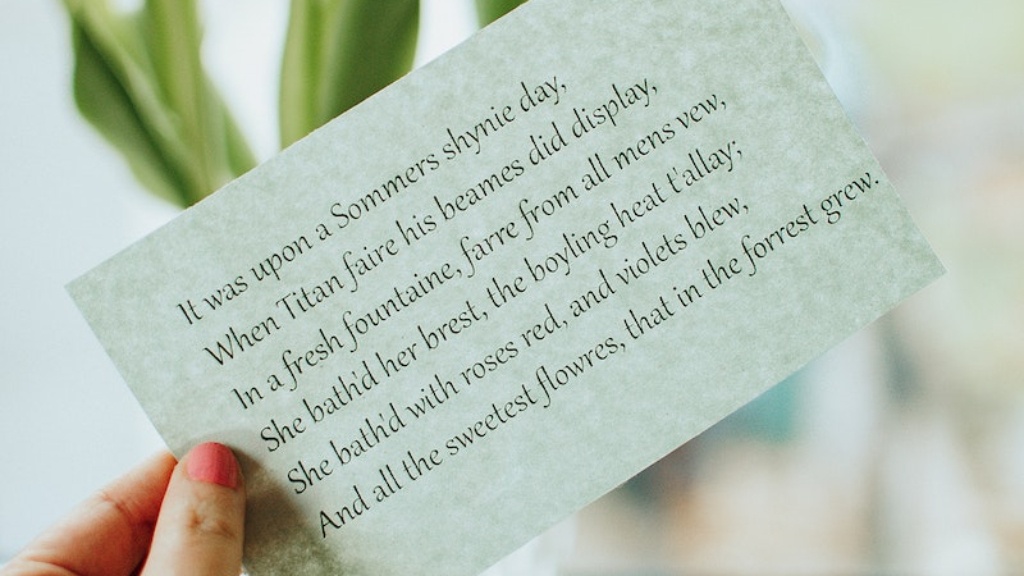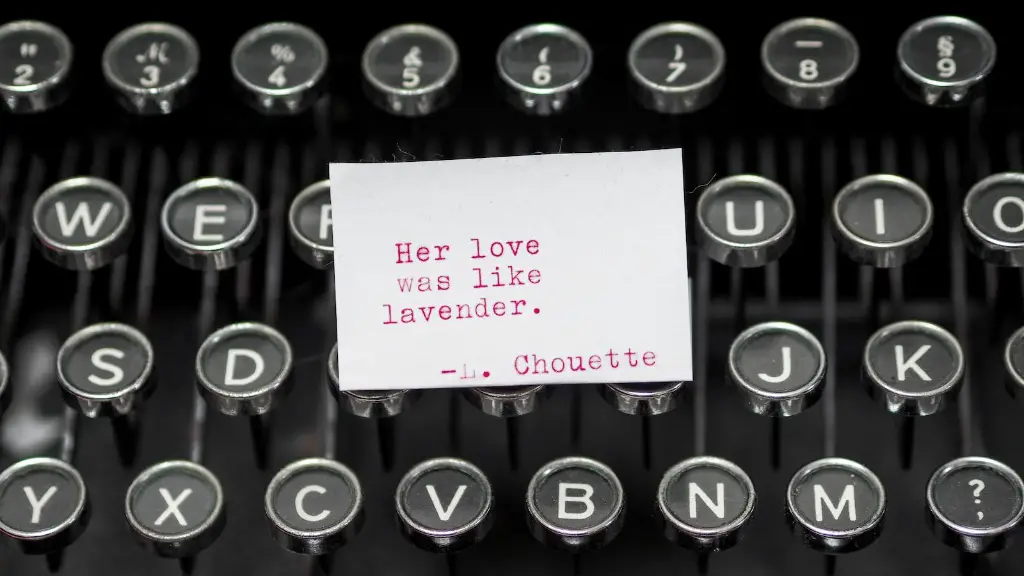Does Poetry Rhyme?
Poetry is one of the oldest forms of literature and is known for its use of beautiful rhythm and language. But while many associate poetry with the use of rhythm and rhyme, there are actually many different styles or approaches to writing poetry. One of the most common questions surrounding poetry is whether or not it must rhyme.
When asking whether poetry must rhyme, it is necessary to first understand the concept of rhyme and its importance in poetry. According to Merriam-Webster dictionary, rhyme is defined as “correspondence of sound between words or the endings of words especially when these are used at the ends of lines of poetry.” Rhyme is thus an important part of many traditional and classical poetic forms in which certain sounds, or syllables, are repeated at the end of each line or verse.
It is important to note, however, that not all poetry needs to be in this traditional form and rhyme is not always present in poetry. In fact, there is a wide variety of approaches to writing poetry, including those that rely on a non-traditional format and those that don’t use any rhyme at all, called “free verse.”
Free verse is a type of poetry that is not bound by any predefined rules. It typically does not have a predetermined rhyme or meter and instead relies on a writer’s creative expression. Still, free verse can have a great impact, particularly when the writing is focused and the words are selected for their resonance and power.
One of the key advantages of free verse is that it allows writers to make use of unique styles, relying on their own creative expression instead of adhering to traditional poetic forms. It is also particularly suitable for contemporary topics or stories, as it has the flexibility to convey a modern or unconventional message without the need for its contents to rhyme.
In this vein, even poets that do adhere to tradition and write in rhyme can use techniques such as “half-rhymes” to break up rhyming patterns and create more interest. Half-rhyme is a form of rhyme in which the words do not rhyme exactly, but only partially or in part. This technique allows poets to add a modern or unique element to their work, while still keeping some form of adherence to traditional poetic forms.
Does Poetry Need to Be in Traditional Form?
The answer to this question largely depends on the context and the writer’s purpose for writing the poem. When writing in a traditional form, such as a sonnet or a haiku, the poet will usually adhere to a traditional rhyme scheme or structure. On the other hand, if the poet wishes to express a contemporary idea or story, then it could be necessary to focus on style and content over form. Poets may also choose to use a mix of traditional and contemporary forms, which could include a combination of traditional structures with more modern elements.
The ability to break from traditional structures and create unique forms presents poets with endless opportunities to explore exciting and contemporary topics. Used in the right way, free verse can be used to create art that is as powerful and moving as its rhyming counterpart, if not more.
This being said, rhyme does still have a place in contemporary poetry. In addition to helping to build a more rhythmic flow, rhyme can bring extra meaning to the poem and make it more engaging for the reader. Thus, the decision on whether to incorporate rhyme into a poem should be based on the individual purpose of the poem or the story the poet wishes to convey.
The Role of Intention
For any type of poetry,whether it uses rhyme or not, the intention and purpose of the poem are paramount. Ultimately, it is the message that is being conveyed, as well as the emotion behind them, that makes a poem truly successful. Thus, while rhyme certainly has its place in poetry, it should not be the ultimate focus; rather, the poet should focus on the message and intent behind it.
The use of traditional forms and structures, as well as more modern elements, is dependent on the purpose of the poem and the message the poet wishes to convey. Regardless of the form chosen, the poet should ensure that the words used have an emotional impact and that the poem is provoking and engaging for the reader.
Analysing Contemporary Poetry
The modern poetry landscape is one rich with diversity and creativity; thus, each poem should be analysed on its own merits and intentions. For example, while a traditional sonnet follows a specific form and rhyme scheme, it can still be used to convey a very modern message. On the other hand, a free verse poem can be just as moving and effective, even if it does not use rhyme at all.
In this sense, there is no standard formula for success when it comes to writing effective and impactful poetry. Each poem should be tailored to the intended message, taking into consideration both the form and content. Ultimately, it is up to the poet to decide how to best use the poem to express their idea or story.
The Impact of Technology
Along with new forms of poetry, the development of technology has also had a huge impact on how we consume poetry. In the digital world, there are many platforms now available to poets, allowing them to share their work with readers worldwide. Social media networks like Twitter and Instagram are full of poetry, with many poets utilising these platforms to express their creativity and reach new audiences.
Technology has also allowed readers to become more engaged with poetry, providing a unique opportunity to interact with the poem and to receive real-time feedback from other users. This has given poets an important platform to share their work, regardless of form or content.
The Art of Poetry Writing
In essence, the art of writing poetry is all about finding the best form and style to convey the poem’s message. Poets should focus on their individual purpose for writing the poem, as well as the impact their words can have on their readers. A great poem should be thought-provoking and emotionally provoking and, ideally, it should also take its readers on a journey.
A poet’s choice of form and style should be thoughtful and relevant to their message. Poets should consider the most appropriate structure and vocabulary they wish to use in order to express the full extent of their ideas or stories.
No matter the choice of structure and style, the focus should remain on creating meaningful poetry that capture the reader’s attention and take them on an adventure.
The Debate Around Rhyme
The debate about whether or not poetry should rhyme continues to be ongoing, with no definitive answer. Ultimately, it depends on the individual purpose and context of the poem, as well as the intent and sentiment behind it. However, what remains clear is that poetry should remain focused on the impact it can have on its readers, regardless of its form or content.
With this in mind, poets should consider their individual approach when writing poetry and select their words and structure based on what is most suitable for conveying their message and engaging readers. If a poet chooses to use rhyme, they should ensure that it is meaningful and impactful to their poem.
The use of rhyme in poetry is a personal choice and should be based on the intended outcome or message. Ultimately, the success of any poem rests with its ability to move and involve its readers, no matter the form or style.
Exploring Different Disciplines
In addition to exploring different forms and styles, poets should also consider combining their poetry with other disciplines such as music, theatre or film. This allows poets to create photo or video representations of their poems, thus giving them more of an opportunity to interact with their audience.
Experimenting across different disciplines can also lead to more creative collaborations, thus providing poets with more opportunities to widen their reach and get their work out to a larger audience. By embracing different disciplines, poets can further explain their message and take their readers on an even more engaging and insightful journey.
Understanding Your Audience
Finally, a key element to writing successful poetry is understanding your target audience and tailoring the poem and its form to them. By understanding the readers that the poet wishes to reach, they can consider whom they want to include or exclude and how to best communicate their message to them.
The audience is ultimately the judge of the poem’s success and, thus, it is important that the poet understands who their readers are and how they are likely to react to their work.
Poetry is ultimately a form of expression, or a way to communicate an idea or story with words. With this in mind, the decision on whether or not to incorporate rhyme into a poem should be based on the individual purpose and, most importantly, the power of the meaning behind the words and the intended outcome for the poem.





